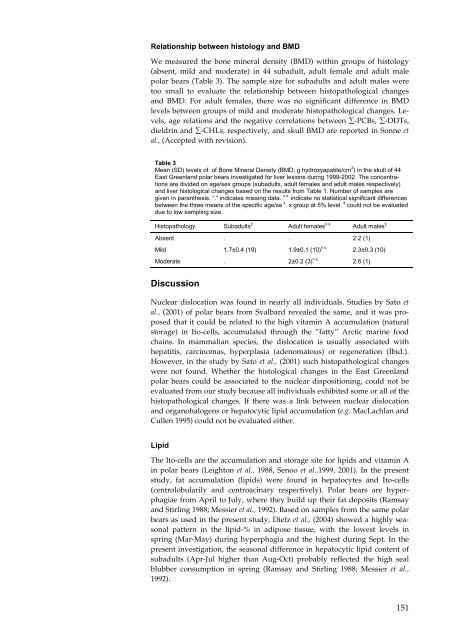Organohalogen concentrations and a gross and histologic ...
Organohalogen concentrations and a gross and histologic ...
Organohalogen concentrations and a gross and histologic ...
Create successful ePaper yourself
Turn your PDF publications into a flip-book with our unique Google optimized e-Paper software.
Relationship between histology <strong>and</strong> BMD<br />
We measured the bone mineral density (BMD) within groups of histology<br />
(absent, mild <strong>and</strong> moderate) in 44 subadult, adult female <strong>and</strong> adult male<br />
polar bears (Table 3). The sample size for subadults <strong>and</strong> adult males were<br />
too small to evaluate the relationship between histopathological changes<br />
<strong>and</strong> BMD. For adult females, there was no significant difference in BMD<br />
levels between groups of mild <strong>and</strong> moderate histopathological changes. Levels,<br />
age relations <strong>and</strong> the negative correlations between ∑-PCBs, ∑-DDTs,<br />
dieldrin <strong>and</strong> ∑-CHLs, respectively, <strong>and</strong> skull BMD are reported in Sonne et<br />
al., (Accepted with revision).<br />
Table 3<br />
Mean (SD) levels of of Bone Mineral Density (BMD; g hydroxyapatite/cm 2 ) in the skull of 44<br />
East Greenl<strong>and</strong> polar bears investigated for liver lesions during 1999-2002. The <strong>concentrations</strong><br />
are divided on age/sex groups (subadults, adult females <strong>and</strong> adult males respectively)<br />
<strong>and</strong> liver <strong>histologic</strong>al changes based on the results from Table 1. Number of samples are<br />
given in paranthesis. “.” indicates missing data. n.s. indicate no statistical significant differences<br />
between the three means of the specific age/se s . x group at 5% level. ‡ could not be evaluated<br />
due to low sampling size.<br />
Histopathology Subadults ‡<br />
Adult females n.s.<br />
Adult males ‡<br />
Absent . . 2.2 (1)<br />
Mild 1.7±0.4 (19) 1.9±0.1 (10) n.s.<br />
2.3±0.3 (10)<br />
Moderate . 2±0.2 (3) n.s.<br />
2.6 (1)<br />
Discussion<br />
Nuclear dislocation was found in nearly all individuals. Studies by Sato et<br />
al., (2001) of polar bears from Svalbard revealed the same, <strong>and</strong> it was proposed<br />
that it could be related to the high vitamin A accumulation (natural<br />
storage) in Ito-cells, accumulated through the ”fatty” Arctic marine food<br />
chains. In mammalian species, the dislocation is usually associated with<br />
hepatitis, carcinomas, hyperplasia (adenomatous) or regeneration (Ibid.).<br />
However, in the study by Sato et al., (2001) such histopathological changes<br />
were not found. Whether the <strong>histologic</strong>al changes in the East Greenl<strong>and</strong><br />
polar bears could be associated to the nuclear dispositioning, could not be<br />
evaluated from our study because all individuals exhibited some or all of the<br />
histopathological changes. If there was a link between nuclear dislocation<br />
<strong>and</strong> organohalogens or hepatocytic lipid accumulation (e.g. MacLachlan <strong>and</strong><br />
Cullen 1995) could not be evaluated either.<br />
Lipid<br />
The Ito-cells are the accumulation <strong>and</strong> storage site for lipids <strong>and</strong> vitamin A<br />
in polar bears (Leighton et al., 1988, Senoo et al.,1999, 2001). In the present<br />
study, fat accumulation (lipids) were found in hepatocytes <strong>and</strong> Ito-cells<br />
(centrolobularily <strong>and</strong> centroacinary respectively). Polar bears are hyperphagiae<br />
from April to July, where they build up their fat deposits (Ramsay<br />
<strong>and</strong> Stirling 1988; Messier et al., 1992). Based on samples from the same polar<br />
bears as used in the present study, Dietz et al., (2004) showed a highly seasonal<br />
pattern in the lipid-% in adipose tissue, with the lowest levels in<br />
spring (Mar-May) during hyperphagia <strong>and</strong> the highest during Sept. In the<br />
present investigation, the seasonal difference in hepatocytic lipid content of<br />
subadults (Apr-Jul higher than Aug-Oct) probably reflected the high seal<br />
blubber consumption in spring (Ramsay <strong>and</strong> Stirling 1988; Messier et al.,<br />
1992).<br />
151

















